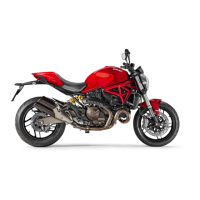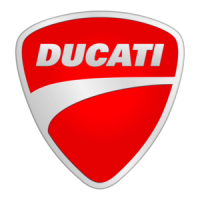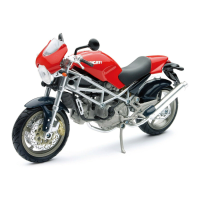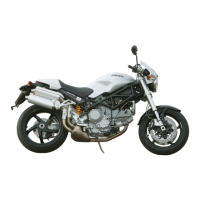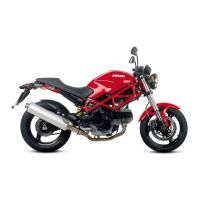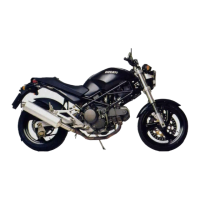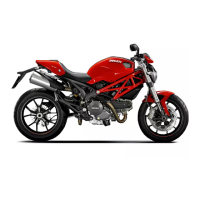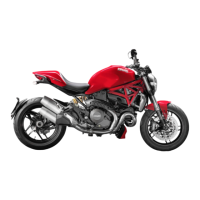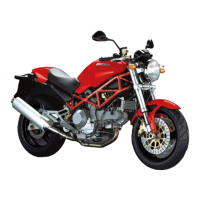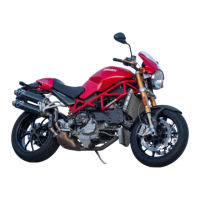Do you have a question about the Ducati MONSTER 821 and is the answer not in the manual?
General safety recommendations, rider obligations, and essential guidelines for safe operation.
Explains warning symbols and specifies approved riding surfaces and restrictions.
Details requirements for licenses, alcohol/drug use, helmet use, and rider experience.
Covers proper protective gear, pre-ride checks, and safe riding posture.
Provides instructions on safe refuelling, fuel compatibility, weight limits, and luggage.
Covers hazards of products and explains vehicle/engine identification numbers.
Details the various indicators, lights, and functions on the motorcycle's dashboard.
Lists acronyms, abbreviations, and defines key terms like Riding Mode and Power Mode.
Provides UE directive information and describes the operation of handlebar function buttons.
Explains parameter display, main functions like RPM, speed, gear, and mode settings.
Details DTC and ABS status display, menu functions, and specific data like odometer and trip meters.
Explains lap time recording and how engine coolant temperature is displayed.
Describes display of instantaneous/average fuel consumption, average speed, and trip time.
Explains ambient temperature display and how to set the clock.
Details the multimedia system, Bluetooth connectivity, and music player operation.
Addresses common issues with notifications, earphones, music playback, and caller display.
Covers service indications, general warnings, high coolant temp, and ice warnings.
Explains low battery, error warnings, and side stand status display.
Guides on accessing the setting menu and customizing modes, ABS, DTC, and engine power.
Details how to customize display modes and adjust instrument panel backlighting.
Explains PIN code functionality, entering, changing, and restoring operation via PIN.
Covers LAP function menu, displaying stored laps, and setting measurement units.
Provides instructions for setting the motorcycle's date and clock time.
Details pairing new devices, deleting paired devices, and device connection management.
Allows viewing service intervals and system details like battery and RPM.
Explains tire setting, recalibration, suspension adjustment, and related settings.
Describes operation of low/high beam lights and turn indicators.
Covers hazard function operation and the motorcycle's anti-theft immobilizer system.
Details key functions, operation, safety, and duplication procedures.
Identifies and describes the location and function of all motorcycle controls.
Details ignition switch, handlebar switches, clutch lever, and throttle operation.
Explains front/rear brake levers/pedals and gear change pedal operation and adjustment.
Identifies key motorcycle components and their positions on the vehicle.
Details operation of fuel tank plug, seat lock, and helmet cable.
Covers side stand operation and adjustment of rear shock absorber settings.
Provides recommendations for initial riding, load limits, and running-in procedures.
Lists essential pre-ride checks and explains ABS device inspection.
Details the procedure for starting the engine and safely moving the motorcycle off.
Covers braking techniques, ABS, and the correct procedure for stopping the motorcycle.
Provides instructions on refuelling, fuel compatibility, and safe parking procedures.
Lists tool kit contents and covers main maintenance tasks like coolant and brake fluid checks.
Details procedures for charging, removing, and refitting the motorcycle battery.
Covers checking drive chain tension, lubrication, and related adjustments.
Describes how to change bulbs and align the headlight beam.
Covers tyre pressure, checks for punctures, replacement, and balancing.
Details checking engine oil level and cleaning/replacing spark plugs.
Provides guidelines for motorcycle cleaning, washing, and proper storage procedures.
Outlines maintenance operations to be carried out by the dealer and customer.
Provides detailed specifications including weights, dimensions, fluids, engine, and brakes.
Details transmission system, frame construction, wheels, and tyre specifications.
Covers suspension, exhaust, available colours, and basic electric system components.
Explains fuse locations, ratings, and provides a key for the electric system diagram.
General safety recommendations, rider obligations, and essential guidelines for safe operation.
Explains warning symbols and specifies approved riding surfaces and restrictions.
Details requirements for licenses, alcohol/drug use, helmet use, and rider experience.
Covers proper protective gear, pre-ride checks, and safe riding posture.
Provides instructions on safe refuelling, fuel compatibility, weight limits, and luggage.
Covers hazards of products and explains vehicle/engine identification numbers.
Details the various indicators, lights, and functions on the motorcycle's dashboard.
Lists acronyms, abbreviations, and defines key terms like Riding Mode and Power Mode.
Provides UE directive information and describes the operation of handlebar function buttons.
Explains parameter display, main functions like RPM, speed, gear, and mode settings.
Details DTC and ABS status display, menu functions, and specific data like odometer and trip meters.
Explains lap time recording and how engine coolant temperature is displayed.
Describes display of instantaneous/average fuel consumption, average speed, and trip time.
Explains ambient temperature display and how to set the clock.
Details the multimedia system, Bluetooth connectivity, and music player operation.
Addresses common issues with notifications, earphones, music playback, and caller display.
Covers service indications, general warnings, high coolant temp, and ice warnings.
Explains low battery, error warnings, and side stand status display.
Guides on accessing the setting menu and customizing modes, ABS, DTC, and engine power.
Details how to customize display modes and adjust instrument panel backlighting.
Explains PIN code functionality, entering, changing, and restoring operation via PIN.
Covers LAP function menu, displaying stored laps, and setting measurement units.
Provides instructions for setting the motorcycle's date and clock time.
Details pairing new devices, deleting paired devices, and device connection management.
Allows viewing service intervals and system details like battery and RPM.
Explains tire setting, recalibration, suspension adjustment, and related settings.
Describes operation of low/high beam lights and turn indicators.
Covers hazard function operation and the motorcycle's anti-theft immobilizer system.
Details key functions, operation, safety, and duplication procedures.
Identifies and describes the location and function of all motorcycle controls.
Details ignition switch, handlebar switches, clutch lever, and throttle operation.
Explains front/rear brake levers/pedals and gear change pedal operation and adjustment.
Identifies key motorcycle components and their positions on the vehicle.
Details operation of fuel tank plug, seat lock, and helmet cable.
Covers side stand operation and adjustment of rear shock absorber settings.
Provides recommendations for initial riding, load limits, and running-in procedures.
Lists essential pre-ride checks and explains ABS device inspection.
Details the procedure for starting the engine and safely moving the motorcycle off.
Covers braking techniques, ABS, and the correct procedure for stopping the motorcycle.
Provides instructions on refuelling, fuel compatibility, and safe parking procedures.
Lists tool kit contents and covers main maintenance tasks like coolant and brake fluid checks.
Details procedures for charging, removing, and refitting the motorcycle battery.
Covers checking drive chain tension, lubrication, and related adjustments.
Describes how to change bulbs and align the headlight beam.
Covers tyre pressure, checks for punctures, replacement, and balancing.
Details checking engine oil level and cleaning/replacing spark plugs.
Provides guidelines for motorcycle cleaning, washing, and proper storage procedures.
Outlines maintenance operations to be carried out by the dealer and customer.
Provides detailed specifications including weights, dimensions, fluids, engine, and brakes.
Details transmission system, frame construction, wheels, and tyre specifications.
Covers suspension, exhaust, available colours, and basic electric system components.
Explains fuse locations, ratings, and provides a key for the electric system diagram.
| Displacement | 821 cc |
|---|---|
| Power | 109 hp (80 kW) @ 9, 250 rpm |
| Transmission | 6-speed |
| Frame | Tubular steel Trellis frame |
| Rear Brake | 245 mm disc, 2-piston caliper |
| Seat Height | 785 - 810 mm (30.9 - 31.9 in) |
| ABS | Standard |
| Engine Type | L-Twin, 4 valves per cylinder, Desmodromic, liquid cooled |
| Torque | 86 Nm (63 lb-ft) @ 7, 750 rpm |
| Front Suspension | 43 mm usd forks |
| Rear Suspension | Adjustable monoshock |
| Front Brake | 2 x 320 mm semi-floating discs, radially mounted Brembo monobloc calipers, 4-piston |
| Dry Weight | 180.5 kg (398 lbs) |
| Fuel Tank Capacity | 16.5 L (4.4 US gal) |
| Traction Control | Ducati Traction Control (DTC) |
| Riding Modes | 3 (Sport, Touring, Urban) |
